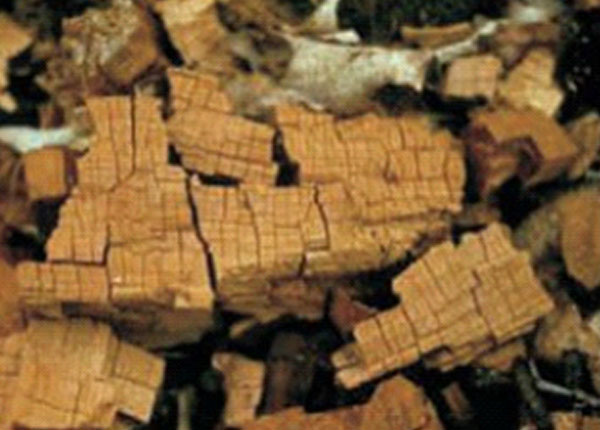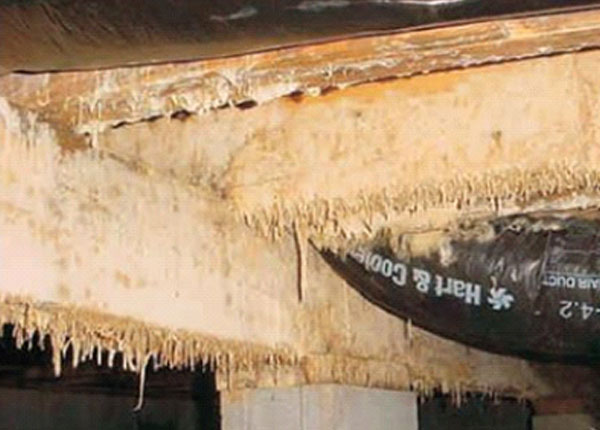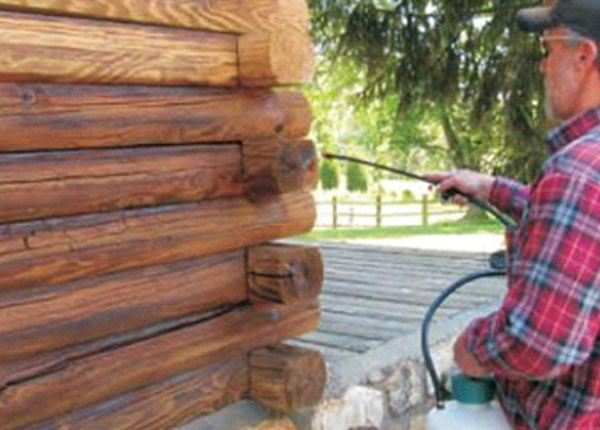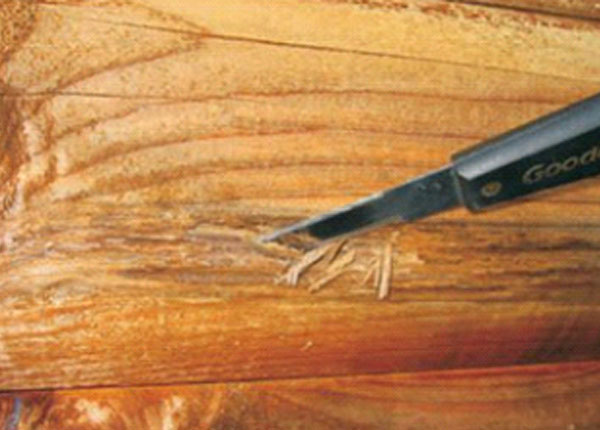Brown rot fungi commonly attack softwoods like pine, spruce and fir thus turning the wood dark brown. In advanced stages of decay, wood attacked by brown rot becomes friable and splits appear across the grain giving the wood a "checkerboard" appearance. Infested wood may be structurally weakened in a relatively short period of time.
Once brown rot has extracted all of the nutrients from the wood, the wood may become dry and powdery. This gives the impression that dry wood has rotted (dry rot) but in reality it is the result of an old infestation of brown rot. One of the most destructive types of brown rot fungi is poria (meruliporia) incrassata, otherwise known as the water-conducting fungus. One indication of a poria infestation is the presence of rot in wood with no visible source of water. This type of fungus actually transports water through root-like structures known as rhizomorphs. Infestations of poria can progress quite rapidly destroying portions of flooring and wood members in a year or two. Thankfully, infestations of poria incrassata are fairly rare.
White rot fungi attack the cellulose and lignin in wood, eventually giving the wood an off-white appearance. In the later stages the wood may become spongy to the touch. Wood attacked by white rot lacks the cubical checking appearance of brown-rotted wood. Shelf fungi, bracket fungi, and mushrooms are all forms of white rot fungi.
Preventing Decay – 7 Rules
Moisture control should be an integral part of any program designed for preventing wood decay. The following 7 rules are a good place to start:
- Wood should never be in contact with the ground. Wood posts, piers, supports, etc. should rest on metal plates imbedded into concrete footers raised above the level of the surrounding soil.
- Basements should be waterproof and equipped with a floor drain. If the relative humidity in the basement exceeds 50%, a dehumidifier should be installed.
- Crawlspaces should be adequately ventilated with at least one square foot of free vent area for every 500 square feet of crawl space floor area along with a moisture barrier covering at least 80% of floor. One vent should be placed within three feet of each corner to prevent "dead air" spaces. In high humidity environments additional vents should be considered.
- Plumbing leaks should be repaired as soon as they are noticed.
- Rain gutters need to be clear of debris and roof leaks fixed.
- All exterior wood surfaces should be coated with a long lasting, water repellent finish system. This is especially important on log homes. Water-based, breathable film-formers like LIFELINE stains and topcoats work best since they allow water vapor to escape while preventing liquid water from penetrating into the wood. Log ends should be provided an extra measure of protection with Log End Seal.
- Upward facing checks should be sealed with Check Mate 2 to prevent water from entering the interior of the logs.
Borate Preservatives
 There are four borate products designed for the control and prevention of decay fungi. Shell-Guard Concentrate and Shell-Guard® RTU are borate-glycol liquids that kill wood decay fungi and when properly applied to bare wood and protected with our finish system, provide permanent protection against decay.
There are four borate products designed for the control and prevention of decay fungi. Shell-Guard Concentrate and Shell-Guard® RTU are borate-glycol liquids that kill wood decay fungi and when properly applied to bare wood and protected with our finish system, provide permanent protection against decay.
Armor-Guard® is a pure borate powder that is dissolved in water and applied to the wood. Since it does not exhibit the depth of penetration of the Shell-Guard borate-glycol products, Armor-Guard should only be used to protect new, un-infested wood. Any time the surface is stripped of its finish, another application of Armor-Guard should be made.
Cobra™ Rods are two-inch-long, borate glass rods that can be used to spot treat decay prone areas such as log ends that are already coated with a finish. Once inserted into damp or wet wood, the borate/copper complex in Cobra Rods dissolves, spreading the active ingredients into areas surrounding the rod. Cobra Rods eliminate active decay fungi and help prevent rot for eight to ten years.
If you have any questions about controlling decay fungi or repairing decayed wood, give Perma-Chink Systems a call at 1-800-548-3554. We have number of products that are designed for repairing damaged wood and preventing future problems from occurring.

 More wood is replaced each year because of decay damage than all other factors combined! Commonly called rot, wood destroying fungi need three things to survive: air, water, and food. Since we can't eliminate air and their food is the wood in our homes, the only mechanical control mechanism available to us is the elimination of water. Water is the enemy of wood! Although we've all heard the term "dry rot," dry wood will not rot!
More wood is replaced each year because of decay damage than all other factors combined! Commonly called rot, wood destroying fungi need three things to survive: air, water, and food. Since we can't eliminate air and their food is the wood in our homes, the only mechanical control mechanism available to us is the elimination of water. Water is the enemy of wood! Although we've all heard the term "dry rot," dry wood will not rot!